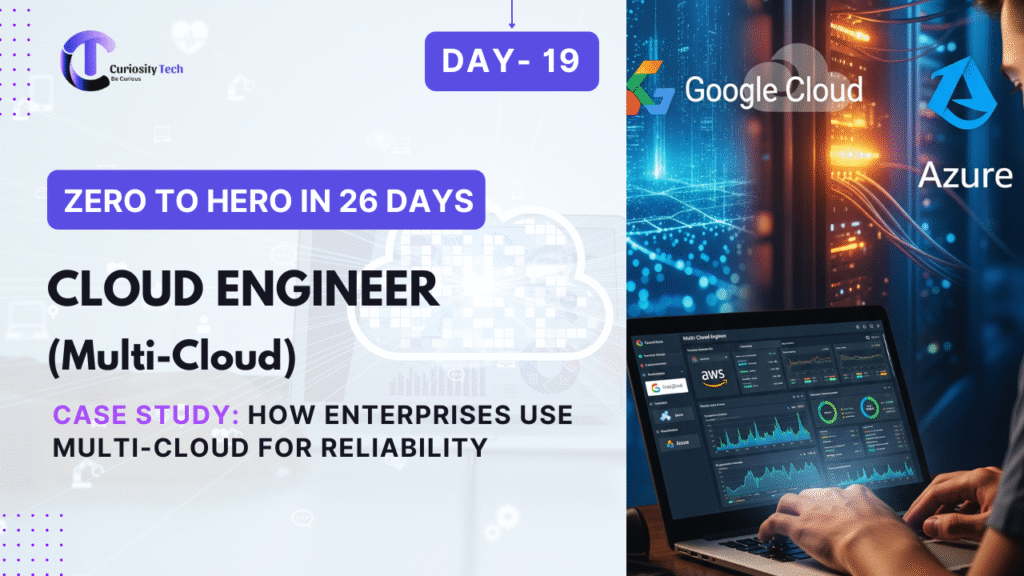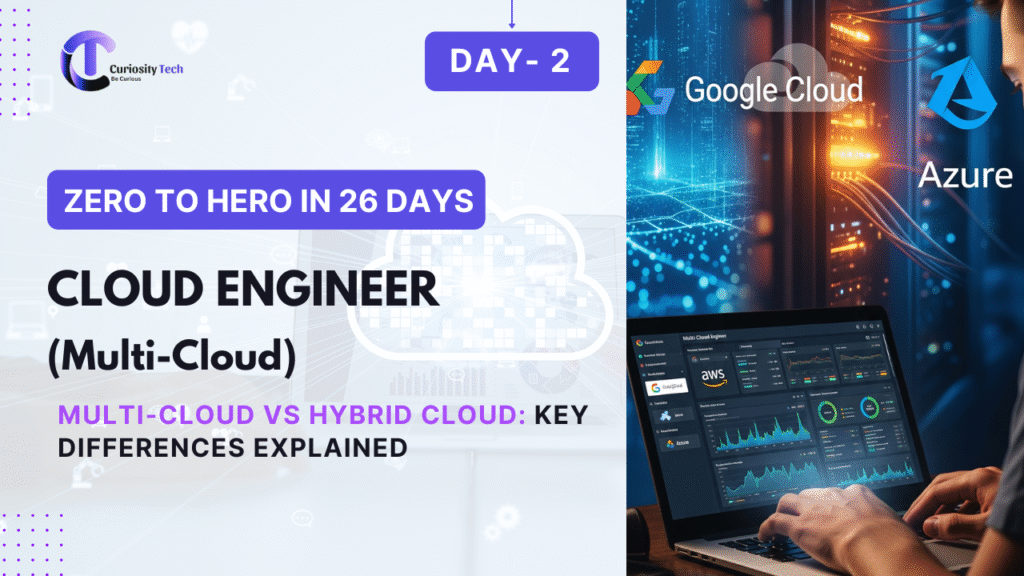Introduction
Reliability has become the new currency of digital businesses. In the cloud-first world, downtime equals lost trust, lost revenue, and lost market share.
Single-cloud architectures deliver resilience — but they can’t guarantee immunity from provider-wide outages. That’s why enterprises increasingly adopt multi-cloud strategies.
At CuriosityTech.in, we work with engineers and decision-makers who study these real-world case studies to bridge theory with practice.
Case Study 1 – Global Bank (Finance Sector)
Challenge:
- Regulatory pressure to avoid dependency on a single cloud.
- Must ensure 24/7 access for ATM and mobile transactions.
Solution:
- Primary workloads in AWS (EC2, RDS, KMS).
- Secondary failover workloads in Azure (VMs, SQL Database).
- Global DNS (Route 53 + Azure Traffic Manager) handles cross-cloud routing.
Result:
- During a simulated AWS regional outage, 95% of transactions rerouted via Azure in <90 seconds.
- Regulators satisfied: compliance with financial continuity requirements.
Case Study 2 – Healthcare Provider (HIPAA Compliance)
Challenge:
- Store and process patient records with zero downtime.
- Ensure compliance with HIPAA + GDPR.
Solution:
- Multi-cloud EHR system:
- GCP → data analytics (BigQuery).
- AWS → operational systems (EC2, RDS).
- Azure → backup replicas in Blob + AD integration.
- GCP → data analytics (BigQuery).
- Encryption keys managed with multi-cloud KMS (AWS KMS + Azure Key Vault).
Result:
- Achieved 99.99% uptime across platforms.
- Data residency requirements met: EU patients on Azure, US patients on AWS.
- Auditors praised cross-cloud compliance framework.
Case Study 3 – E-Commerce Giant
Challenge:
- Handle traffic surges during festive sales.
- Ensure order management system doesn’t crash.
Solution:
- Active-active deployment:
- AWS Lambda functions for checkout.
- Azure Functions for order invoices.
- GCP Pub/Sub + Functions for event-driven data sync.
- AWS Lambda functions for checkout.
- Cloudflare Load Balancer spreads requests across providers.
Result:
- Handled 10M+ transactions in a day without downtime.
- Multi-cloud ensured resilience when AWS Lambda experienced latency spikes — Azure & GCP picked up the slack.
Case Study 4 – Media & Entertainment (Streaming Platform)
Challenge:
- Deliver video streams with zero buffering, even during global sports events.
Solution:
- Multi-CDN + Multi-Cloud model:
- Content storage in AWS S3.
- Transcoding in Azure Media Services.
- Recommendation engine in GCP Vertex AI.
- Content storage in AWS S3.
- Global load balancing with Akamai + GCP Global LB.
Result:
- Achieved 5x faster failover during regional CDN outages.
- User retention improved by 18% due to smoother streaming.
Section 5 – Lessons Learned Across Enterprises

Section 6 – Common Patterns
At CuriosityTech Nagpur workshops, learners dissect these patterns by building miniature replicas of enterprise case studies.
Section 7 – Becoming an Expert in Reliability Engineering
Multi-cloud reliability expertise requires:
- Deep knowledge of HA architectures.
- Familiarity with compliance-driven design.
- Mastery of cross-cloud networking and DNS.
- Practicing with chaos drills & simulations.
CuriosityTech encourages engineers to simulate “day-in-the-life of an SRE”, where they must handle live outages across providers.
Conclusion
Enterprises don’t adopt multi-cloud just for “fashion” — they do it for survival, compliance, and customer trust.
From banks to streaming platforms, the theme is consistent: multi-cloud reliability is an enabler of business continuity and competitive advantage.
At CuriosityTech.in, we emphasize that learning from enterprise case studies shortens the path to mastery — because theory without context never survives first contact with reality.



